This post contains affiliate links.
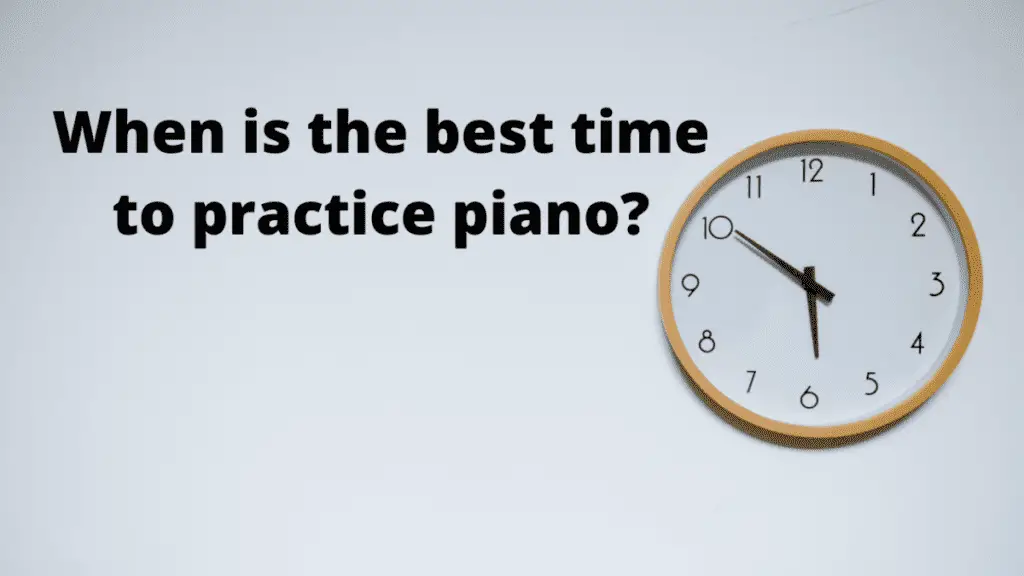
Have you ever wondered at what time is most effective for practicing piano during the day? Where your brain is at its peak and you can practice your piano techniques and absorb music theories more quickly and effectively.
Science shows that the morning is the most effective time to practice piano. You’re fully energized and there are little outside noises to distract you. However, each person’s brain works best at different times, so experiment to see when is the best time to practice piano for you.
In this article, I’ll talk about at what time precisely is best to practice piano, according to science, along with the why.
I’ll also explain why what science says doesn’t matter too much and you should practice piano when you’re free and most motivated, backed by results from a survey I hosted.
Lastly, I’ll also talk about how long you should spend practicing piano and what you should be practicing, since playing pieces isn’t the only aspect of learning the piano.
What time in the morning is best for practicing piano?
While there are no dedicated studies on when is the best time to practice piano, science has shown that learning is the most effective from 10 am-2 pm and 4 pm-10 pm. This is when your brain is at its peak and will absorb more information easily, making learning the piano more effective.
Meanwhile, the worst time to learn piano is between 4 am and 7 am when your brain is too tired and isn’t capable of thinking and absorbing information.
Aside from scientific reasons, there are other reasons why practicing piano in the morning is better:
Reasons why the morning is the best time to practice piano
The brain is fresh and you’re energized
After sleeping through the night, your brain is reset and you’re fully energized. Thus, this is the best time to practice piano before your mind is muddled with stress from work or study later during the day.
Also, when waking up early, you feel like you have more time in the day compared to working late into the night and waking up late. This means you’ll have more time to practice piano.
Try waking up early and practicing piano or doing other work. For me, nothing beats the feeling of finishing some work before lunchtime starts.
On the other hand, if you practice in the afternoon after work or in the evening, you may be too tired to practice piano and just want to kick back and relax by watching Netflix.
Little outside noises
Most people are still asleep in the early morning so there aren’t many cars outside on the streets to distract you. Not to mention noises inside the house if you have pets or babies.
Furthermore, if you choose to practice piano at night instead of in the morning, you may disturb your neighbours if you’re living in an apartment complex or you have thin walls.
Natural light
Nothing beats the feel of cool air in the morning blowing in the room where you’re practicing piano, while the warm sunlight prickles your hands. Not to mention the vitamin D you’re getting from the sun.
Practicing piano after noon when the sun is at its highest, its beam is hot and uncomfortable to the skin, making close the blinds to escape it.
Meanwhile, practicing piano during the night means you will waste money on the electricity needed by the lights.

The best time to practice piano differs for each person
With that said, while the morning is arguably the best time to practice piano for most people, it may not hold true for you. It could be because you don’t have free time or you can barely keep your eyes open in the morning, let alone practice piano!
Each person’s brain works differently, some are night owls that are more focused at night while others are early risers that are the most energetic in the morning. There’s no reason the practice in the morning if you’re a night owl that gets more stuff done at night.
The best time to practice piano also depends on your schedule and what free time you have during the day. Many people have work or school in the morning and can’t practice piano until they get back home in the afternoon since brushing their teeth, washing their faces, dressing up and eating breakfast have already taken up all of their morning time.
However, some people prefer to wake up a bit earlier so they can relax, take a sip of coffee and play the piano right before going the work or school.
For me, since I can’t wake up early, so I practice piano in the afternoon after I come home from college, right before dinner. Then I spend the night doing homework. That type of schedule works for me.
Thus, this is why you should experiment to see when is the most effective time to practice piano for you:
- Practice one week in the morning and record your progress with the pieces you’re learning and how satisfied and focused you are when practicing.
- Repeat the same process for the afternoon and evening for another 2 weeks.
- Compare results and conclude the best time to practice, when you make the most progress, enjoy practicing the most while staying focused.
Survey results on the best time to practice piano
I held a survey asking people when they practice piano so I can conclude when is the best time during the day to practice piano. Out of the 190 responses, here are the results:
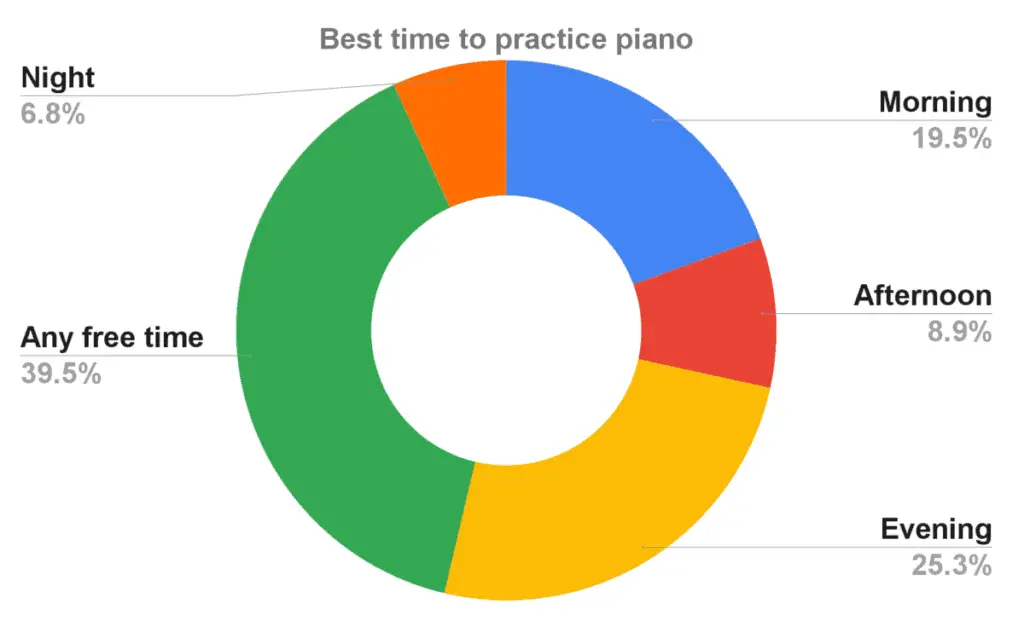
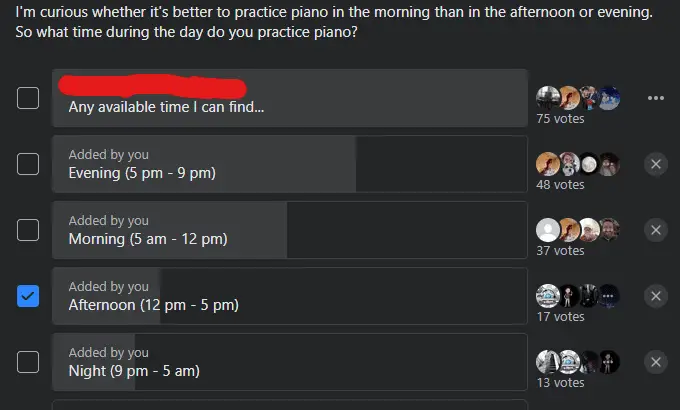
With the most popular response being “Any available time I can find” with 75 votes, this shows that despite what science says, if you’re a busy person then you should practice piano whenever you can. What’s more important than when to practice is that you need to practice piano every day consistently, since practice makes perfect.
I have a busy schedule so really any time I can find, but i do like the morning better when I manage to. I fell more productive in everything in the morning
The second highest voted option is “Evening” with 48 votes, showing that many people get home from work or school in the afternoon, wash up and eat dinner before practicing piano in the evening.
I practice in the evening, cause I’m usually really tired and late in the morning lol. Right after work is perfect
I’m a night owl, so no way I’m getting up earlier that what needed for work to practice my piano. So I do it in the evening, between 7 and 11pm. (I finish work around 6pm).
Following closely behind is the “Morning” option with 37 votes. These people are willing to wake up earlier to practice piano because their minds are sharper at that time, and they aren’t stressed out from work yet.
My only real opportunity is in the morning, before the responsibilities of the day take over. Fortunately, that is also my most alert, focused and productive time
I practice first thing in the morning before work, then in the evening. My morning practice is usually more productive, but I have more time in the evening.
The least voted options are the afternoon (17 votes) since most people aren’t back home from work or school yet, and the late at night (13 votes) when most people are getting ready to go to sleep or are already asleep.
How long should you be practicing piano?
You may have heard stories of concert pianists spending up to 6 hours every day practicing piano, with some practicing even more than that. That begs the question: should you be practicing that much? How long should piano practice sessions be at least to be effective?
The answer is “it depends”. If you’re really passionate about the piano and want to progress as quickly as possible with the piano, then you can practice 6 hours per day. However, most of us have other responsibilities and can’t dedicate that much time to practicing the piano.
Even for concert pianists, the reason why they practise so much is that it’s their job and they need to prepare for an upcoming concert.
With that said, you should aim to practice piano for at least 30 minutes every day. This is because aside from learning piano pieces, you should also spend time sharpening your piano techniques through practicing scales and arpeggios or doing sight-reading exercises. You may also choose to learn music theory. 30 minutes will barely be enough if you choose to do all of these during your practice sessions.
The reason why you want to spend time doing other things aside from just learning new pieces is that improving your techniques and learning music theory can help you improve at the piano much faster and more effectively.
Practicing piano scales and arpeggios develops your finger strength and dexterity to better prepare you for harder piano pieces. Arpeggios also help you get more comfortable with awkward fingerings since many arpeggios require you to tuck your thumb and reach for longer notes.
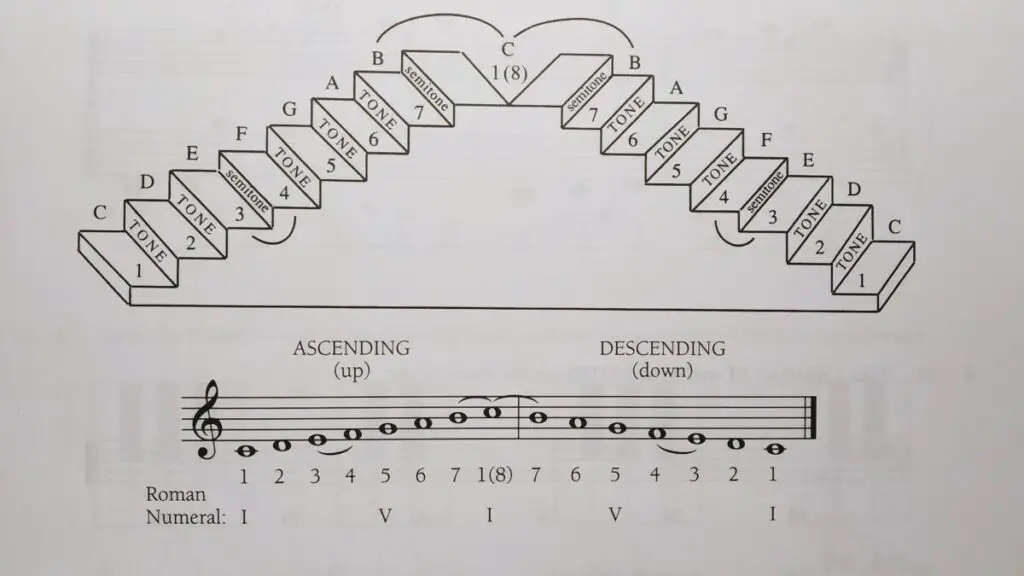
They can also be a warm-up exercise to get the blood flowing in your hands and fingers before you start playing any piano piece. I wrote an article detailing the many more benefits of practicing scale Can You Learn Piano without Knowing Piano Scales? (and why you should learn scales anyway)
Meanwhile, doing sight-reading exercises will help you gradually be able to play piano pieces by just looking at the sheet music, without looking at the keys. Eventually, you’ll be able to play piano pieces by simply scanning the sheet music once and start playing immediately, with no prior practice.
Studying music theory will ensure that you understand what all the symbols on the sheet music mean and how they work. This will make learning any new piano piece easier since you understand the key signature, the rhythm and the different note values within a piece.
While you should practice at least 30 minutes every day, if for some reason, you’re too busy and can’t afford to spend that much time practicing on some days, you should still practice even if it’s only for 10-15 minutes instead of skipping out on practice those days.
This is because, for every day that you don’t practice, you’ll need 3 days of practice to make up for it. Learning the piano is all about practice since practice makes perfect. Thus, practicing 15 minutes every day is better than practicing 2-3 hours on one day, then doing nothing for the rest of the week.
Furthermore, by practicing every day, you’re creating a routine where you sit down and practice piano, without having to motivate yourself to do so because there are some days when you don’t want to practice. This makes practicing much more bearable and almost become second nature to you, where at that exact time, you would sit down and practice without thinking too much about it.
What should you practice during piano practice sessions?
As I mention above, there are 4 things you should work on every practice session: practicing scales and arpeggios, sight-reading exercises, learning music theory and playing piano pieces. Here is how you should structure your practice session:
First 5-10 minutes – music theory (optional)
The first 5-10 minutes should be spent on doing music theory workbooks. Or you can choose to do them separately from your practice session.
A lot of people find this boring and truth be told, it is. It’s the equivalent of school homework. But if you can stomach and get through it, you’ll have a better understanding of the workings of piano music, making playing the piano a lot easier.
As to which theory workbook to get, I recommend the Keyboard Theory Basic Rudiments by Grace Vanderdool.
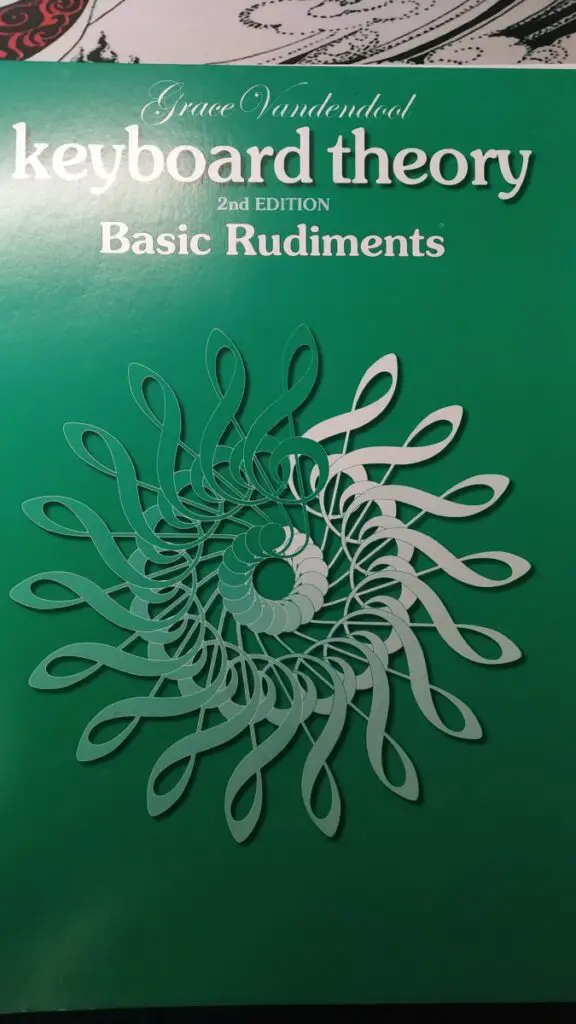
This book lays out the materials in a very logical manner where the next unit would use the knowledge gained from the previous unit. The book teaches you basic knowledge like notes, rests and their values at the beginning, then slowly build up to major, minor scales, triads and rhythm.
Each unit has a few pages of explanation along with pictures of the keyboard to illustrate those points, so you can go through the workbook by yourself. Unfortunately, there’s no answer key to this book so you may need to buy a separate answer key or ask your teacher to check your answer.
You can get this book here on Amazon (affiliate link)
Next 10-15 minutes – practicing scales and arpeggios
For anyone that doesn’t know, a scale is a collection of successive notes that starts on a particular note and ends on that same note but one octave higher. There are different types of scales like Major or minor. Within minor, there are natural minor scales, harmonic minor scales and melodic minor scales.
For example, the C Major scale starts on C and ends on the C next to it on the piano keyboard, including all the white notes in between:

An arpeggio of a scale consists of the 1st (called root), 3rd, 5th notes and another 1st note one octave higher. In total, an arpeggio in one octave has 4 notes. For example, the C Major arpeggio is C-E-G-C.
Playing arpeggios in one octave is simple since you can fit those 4 notes within the 5 fingers on each hand. Playing in two octaves is where it gets tricky.
Take the example of the C Major arpeggio: as you hit the G note with your middle finger, you have to shift your hand to the right so you can tuck your thumb to hit the C note. This will be difficult to get right because you’ll keep missing notes at first. Here’s a video showing how to play the C Major arpeggio:
Between going through the scales and arpeggios that you have already learned and continue learning new scales and arpeggios, it’ll take 10 minutes or even longer, depending on how many scales and arpeggios you want to learn or practice.
Next 10 minutes – sight-reading
For those that don’t know, sight-reading is where you scan a piece of sheet music once to somewhat familiarize yourself with it before reading the sheet and playing it on the piano at the same time.
Sight-reading is a lot harder than it sounds since your brain has to process a lot of information from the sheet music while simultaneously playing it on the piano, making it easier to make mistakes. You only have one chance at playing the tune/piece since practicing beforehand defeats the purpose of sight-reading.
The goal of sight-reading exercises is to get you to the point where you can take songs/pieces requests at parties, scan them once, then play them on the spot with little difficulty or stumbling around.
On what type of sight-reading workbooks to get, you should get the RCM sight-reading series of workbooks that consists of 10 books, from level 1 to level 10.
I like this series because it’s written and published under RCM (Royal Conservatory of Music) which is a prestigious and well-recognized music program here in North America, so you know the materials are going to be high-quality.
Also, the series is split into 10 books that go from easy to hard, which is great since you can tell what level of sight-reading you’re at if you can comfortably finish a workbook of a particular level.
You can get the first book here on Amazon (affiliate link)
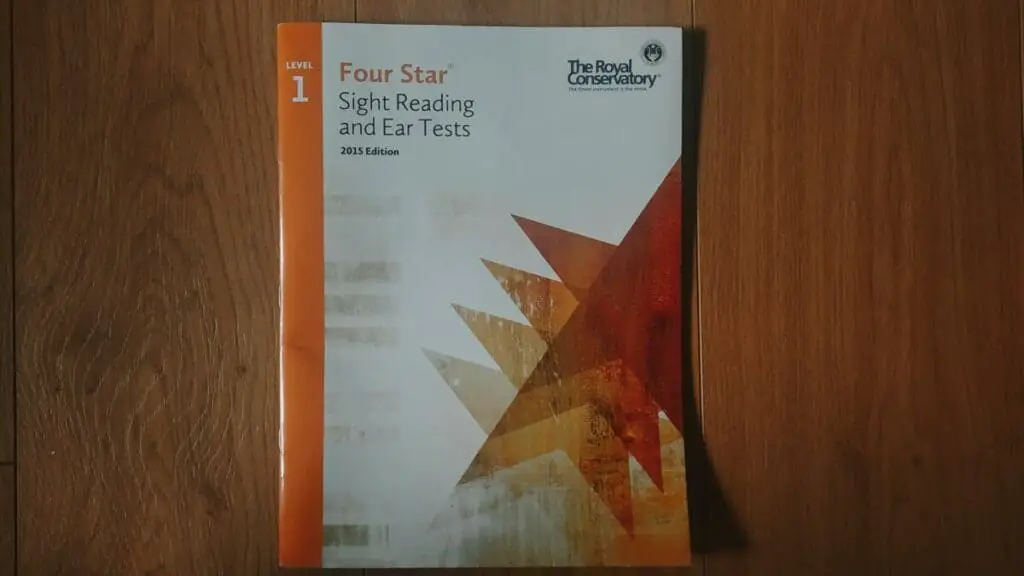
When practicing sight-reading, scan the excerpt once, take note of the first and last notes, any parts that you find difficult and imagine how to play through that part. Then play through the excerpt and don’t stop, even if you make a mistake.
You can try again to see if you can get it right the 2nd time. But don’t replay for the 3rd time since your brain and fingers are now familiarized with the excerpt and now replaying won’t improve your sight-reading.
For the rest of the session – playing piano pieces
After going through all of those tedious training, now it’s time to practice whatever piece you’re learning. Now you play pieces for however long you want – 30 minutes, 1 hour, until you’re bored, etc.

